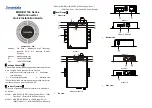
10.1.2
Dynamics and accuracy
10.1.3
Reactive power functions
The following functions for controlling the reactive power are implemented in the devices listed above:
cos ϕ constant
Q constant
cos ϕ /(p/pn)
Q(U) 10 nodes
Reactive power is prioritised in each method. The maximum possible active power that can be fed in is reduced in line
with the P-Q operating range when a specific reactive power level is specified.
cos φ constant
In constant cos ϕ mode, the specified shift factor cos ϕ is permanently set by the inverter. In doing so, the reactive power
level is set in line with Q=P*tan ϕ as a function of the power that continuously generates the specified shift factor cos-ϕ.
If the specification is changed, the new value is adopted by way of a filter in a muted manner. The settling time is 1s with
the transient response of a first-order filter (PT-1) with a time constant of Tau=200ms. The specified shift factor can be
configured on the display or by way of communication via the KACO RS485 protocol and MODBUS/SunSpec.
If the applicable grid code stipulates that the cos-ϕ should react to the target value slower than the configured Tau=200
ms by way of a defined gradient or settling time, this gradient or settling time must be implemented in the system con-
trol.
If the timeout is set to 0 seconds, this is suitable for lasting preservation.
Q constant
In Q-constant mode, the specified reactive power value is permanently set by the inverter. If the specification is changed,
the new value is adopted by way of a filter in a muted manner. The settling time is 1s with the transient response of a
first-order filter (PT-1) with a time constant of Tau=200ms. The specified reactive power can be configured on the display
or by way of communication via the KACO RS485 protocol and MODBUS/SunSpec.
If the applicable grid code stipulates that the reactive power should react to the target value slower than the configured
Tau=200 ms by way of a defined gradient or settling time, this gradient or settling time must be implemented in the sys-
tem control.
If the timeout is set to 0 seconds, this is suitable for lasting preservation.
cos ϕ /(p/pn)
In the cos ϕ / (P / Pn) operating mode, the setpoint value of cos ϕ and the setpoint for the reactive power derived from it
are continuously calculated depending on the actual power level. This function ensures that grid support is provided by
the reactive power when a significant voltage boost is anticipated due to a high feed level. In this case, a characteristic
curve is specified which can be used to configure up to 10 nodes, value pairs for active power and cos ϕ. The active power
is entered as a % in relation to the nominal power. Other parameters allow you to limit functionality and to limit activa-
tion to certain voltage ranges.
Fig. 45:
cos ϕ / (P/Pn) standard characteristic curve with 3 nodes
Powador 30.0-72.0 TL3
Page 56
EN
















































